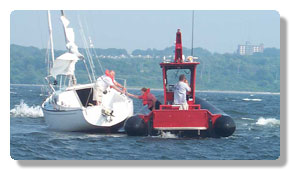Quick Anchoring can be the Key to Avoiding Disaster
A disturbing trend observed frequently by Safe/Sea Captains over the past several boating seasons is the failure of many boaters to recognize the dangers of lee shores and their lack of ability to quickly anchor their vessel when something goes wrong.
A lee shore is any shoreline that you would drift into should your vessel lose power. Most of the time this means the shoreline that is downwind of you, but it can include shorelines down current of your vessel as well.
The degree of danger that is posed to your vessel by a lee shore is directly proportional to the force of the wind and current that is pushing you toward it. If you misjudge this force and then lose power, you can be on the lee shore faster than you can anchor your boat.
Considering the inherent dangers of lee shores, we recommend that a prudent captain should never approach a lee shore closer than one-quarter mile, even in calm conditions, with greater distances recommended as the wind speed increases.
Some of the more dangerous lee shores in Narragansett Bay in the summer when southeast to southwest winds prevail most afternoons include the Warwick Light and Warwick Country Club area, Oakland Beach, the south end of Patience Island close to the Gap, Pine Hill Cove, the T-Wharf area, and the south end of Dyer Island.
Your best defense against a lee shore when you lose power is anchoring quickly and securely. Anchoring your vessel is the very first thing that you should do whenever you lose power in the vast majority of situations.
Quick and effective anchoring can be virtually assured if you follow three simple rules.
First, be sure that you have adequate ground tackle for the size and weight of your boat. Guidlines for this factor can be found in many books on seamanship, including Chapman’s Piloting. Generally, the heavier the anchor and the more chain it has, the quicker and better it will bite into the bottom and hold fast.
Second, be sure that you can access your anchor quickly and that the line isn’t a snarled mess. Even the best anchor in the world won’t help you if it takes you half an hour to extract it from its locker and untangle the rode.
Finally, be sure you give your anchor plenty of scope to help it bite into the bottom. In other words, let out plenty of line so that the anchor’s flukes have the best opportunity to dig into the bottom. Remember, anchors get their holding power from their ability to dig into the bottom, not from their weight. Their weight and chain simply make them dig deeper faster. Once again, excellent instructions for effective anchoring can be found in Champan’s Piloting.
Here at Safe/Sea we strive to provide very fast service when you call for assistance, but many things can affect our response times. On busy weekends, it’s not uncommon for some customers to have to wait nearly an hour for one of our towboats to arrive, so it’s imperative that you be able to safely secure your vessel until we can get to you.
Giving a wide berth to lee shores during your voyages and knowing how to quickly and effectively anchor your vessel will go a long way toward ensuring a safe completion of your day on the water.

